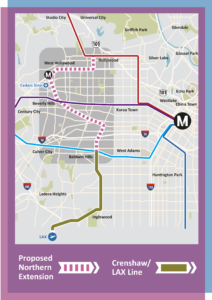I’ve spent the better part of a lifetime waiting for the train, and while it’s never shown up, I still have some reason to hope. When I first moved to West Hollywood in the mid-1980’s, I had just returned from five years in New York City while attending college and afterwards. Though a Southern California native, I had grown accustomed to the quality of life in a city as transit-rich and pedestrian-friendly as New York, and felt its lack when I returned to Los Angeles.
Though it wasn’t a term anyone would have used at the time, I became something of a proto transit geek, following news as the Red and Blue lines were slowly built, pointing out bits of track and abandoned stations left over from the old Red Car system to my patient and bemused friends, and even stumbling upon an already-forgotten RTD study in the cramped old West Hollywood Public Library outlining a never-realized 1982 plan to restore light rail on the old Red Car right of way stretching from Santa Monica to Century City and through Beverly Hills to West Hollywood.
Nothing had come of that plan, and just recently the original route of what is now the Red Line subway had literally been derailed by Congressman Henry Waxman. A widely admired liberal on most domestic and foreign policy issues, Waxman acted like a Reagan Republican when it came to public transportation issues in his own district – the legislation he pushed through Congress at the behest of a small group of affluent Hancock Park residents delayed construction of the Wilshire Blvd portion of the subway for three decades.
That original route would have included a station at Fairfax and Santa Monica Boulevards that would have also served as the eastern terminus of the studied light rail line. Land had been purchased and cleared for the station, and at the time I moved into the neighborhood, a weathered sign announcing imminent construction was still present on the vacant lot. That land on the northwest corner ended up becoming a mini-mall instead, and the closest we have come to a subway station in West Hollywood is the Subway sandwich shop located there.
Thirty years later, plans for a West Hollywood Metro station are once again part of the MTA’s long range plan, backed by city government, and now supported by a sophisticated advocacy group. Budget, funding, and construction issues remain formidable, and the dour predictions I made in my twenties that I would probably be in my sixties by the time that Los Angeles had a truly workable rail transit system now seem either eerily prophetic, or perhaps still overly optimistic.
Even at that, this is progress, and I’m still hoping that one day, perhaps in the same year that I qualify for social security, I might be able to walk to the corner of Santa Monica Blvd and Fairfax, descend stairs into the cool interior of a subterranean station, and hop on a train that will take me…most anywhere I need to go. If so, it will only be happening about forty-five years later than it needed to…but what’s half a lifetime or so when you’re waiting to catch a ride?

